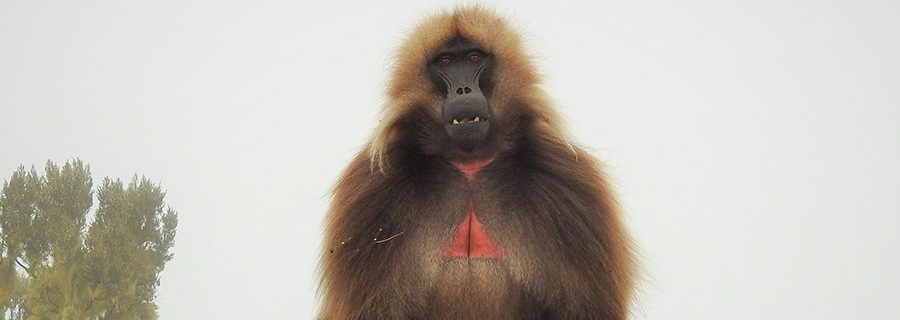Ethiopia is a landlocked country with a unique combination of culture, wildlife, history and nature. From lush highlands to the arid deserts and everything in between, the natural beauty of this African country will leave you speechless. Ethiopia has recently become of more interest to travellers, especially those that are returning to Africa for their second, third or fourth adventure.
Our Managing Director Cathy Elliott recently returned from escorting a group of 10 clients from Adelaide on a 30-day journey through this fascinating destination. We’ve asked Cathy about her experience and found out her recommendations for others wanting to experience Ethiopia.
- When is the best time of the year to visit Ethiopia?
Weather wise, October to April is ideal as this is the dry season. Ethiopia is located on the equator so there really is only two seasons, however due to the altitude the landscapes and climates are really different. We travelled in October, which is just at the end of the rainy season, so the mountains were all covered in beautiful wildflowers. There are also many festivals – Timkat being the biggest and most well-known. This happens around the middle of January each year.
- How long would you recommend people allow to travel here?
It really depends on how much you want to see and how in-depth you want your trip to be. Our trip was extensive and covered some areas rarely included on a regular tour to Ethiopia, but still not everything! Many tours are broken down into a northern circuit and southern circuit, with each being around 10-14 days.

- What wildlife can people experience in Ethiopia? Were you fortunate to have any wildlife encounters?
Ethiopia is well known for its birdlife, with over 830 recorded species, 23 of which are endemic. There are not a lot of the big prey animals usually associated with Africa, although we were told there are still areas where lion and leopard can be found. The main hope for a wildlife encounter is with the Gelada Monkey, also known as the bleeding-heart monkey, the Walia ibex and the critically endangered Ethiopian wolf. We were fortunate enough to see 2 out of 3. We missed the wolf, which was very disappointing, however that was due to the fact that we were unable to get to the Bale Mountains due to unforeseen political problems in the area.

One special moment occurred when we were taken to a spot just outside of Awash, not in a national park, just an open area between a village and the train line and we were promised that we would see hyena – a bold statement I thought, and one left open to absolute disappointment. But that was not to be. As the sun set, a lone hyena came out from a den to check on the safety for her clan. One by one seven hyena ventured out into the fading sunlight. As we sat on a rocky outcrop, downwind but not too far away, our little group were indeed fortunate to see this family head out on their evening forage.

- You visited a variety of tribes along your journey. What did you find the local people like? What was a highlight of meeting and being able to speak with the local tribes?
In truth this experience was varied for me. It is interesting to see the village set up and understand some of the hierarchy, but with the visitation of tourists, so comes the reliance on those tourist dollars and for some villages the feeling of intruding.
We visited six different villages and those that I enjoyed the most were – Karo, Dorze, Dassenach and Ari. There are many reasons I enjoyed these villages, among them – the local guides were knowledgeable, spoke English and made themselves available for any question and they were open about some traditions that we find, well frankly abhorrent – the inhabitants of these villages went about their business and activities as usual, so it felt a much more authentic experience. These villages showed us traditional ways of cooking and making tools, weaving and even invited us to have a go – we were not followed for money from beginning to end, and I did not feel like an intruder but a welcome visitor.
Conversations are complicated and difficult as language is a huge barrier, so having an English-speaking local guide was an enormous benefit

- What money did you take with you, are atm/ credit card facilities available or should travellers go prepared with cash?
This is an interesting question. There are ATMS all over the place – in the middle of the street sometimes! Not always working I must say, but all over the place. I myself used cash as the thing with Ethiopia is that you don’t need much – everything is included for most tours. USD is the easiest currency, but you do need to change to local money – BIRR (approx. 20 to the AUD and 30 to the USD), the official rate offered in banks and hotels and shops. There are no credit card facilities to speak of, even the best hotels do not have credit card options. I came across it once during the entire trip.
- Ethiopia is known for its diverse natural landscapes. Tell us about some of your favourite areas you visited?
The Simien Mountains for sure were a highlight, and the photos don’t always do it justice. I loved this area because of the natural beauty and the wildlife, but I am also saddened because this is a national park that has way too many cows and crops!
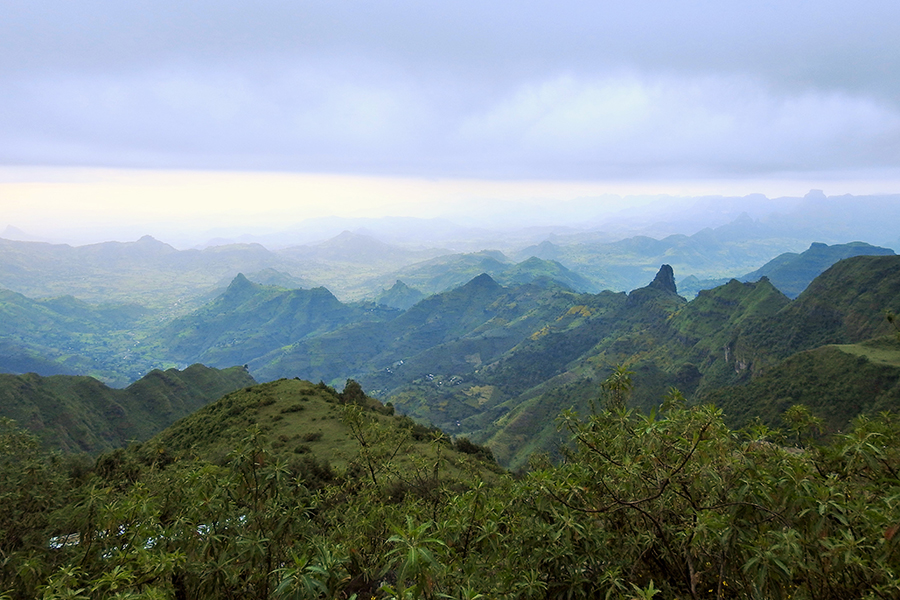
The Simien Mountains
The Blue Nile Falls – incredible. We had been led to believe that the falls may not be flowing as there hadn’t been much rain and much of the water was dammed to run the hydroelectric power station, so when we ran out of time to visit, my thoughts were along the lines of “oh well, probably not missing that much” but overnight it absolutely poured and poured with rain, so we made time to walk to the falls the next day, and we were met by a most incredible sight…Hopefully photos reflect the falls and the might and power of the water, that days before were barely a trickle.
Lake Langano – a lush oasis in a dust bowl. Driving to Lake Langano was like driving through a haze of red powder (all that wonderful topsoil just blowing away) only to come out the other end to a thick forest and views of an enormous lake stretching to the horizon…. with hippos! Such a contrast.
Also, the view from my hotel room in Lalibela across the valley watching the sunset and the sun set across Lake Chamo and its twin Lake Abaya at Arba Minch were also stand outs!

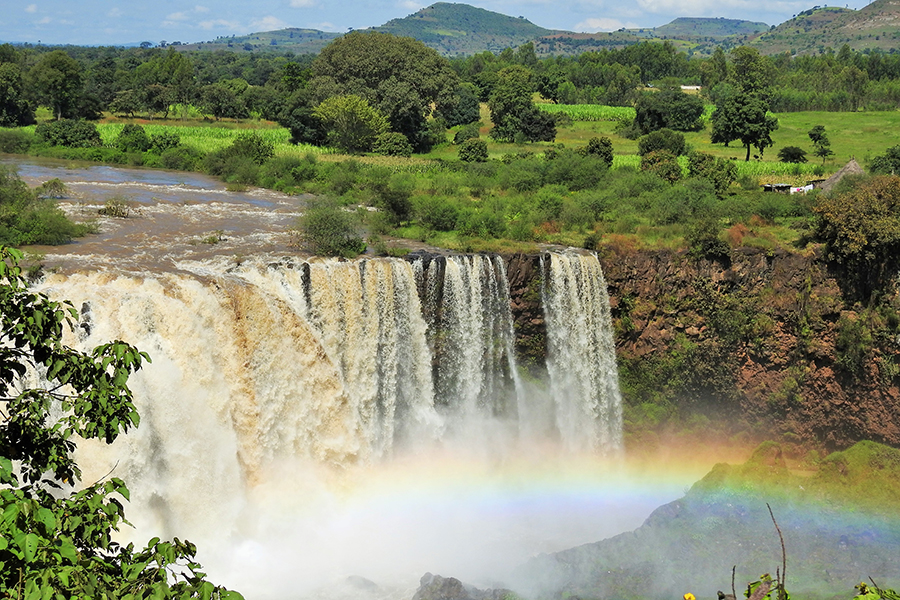
The Blue Nile Falls
- There are some iconic historical sites in Ethiopia. Can you tell us about some you visited?
Aksum, known for its obelisks, (technically they are called stelles) St Mary of Zion Church and the Chapel of the Tablet, which is said to house the Ark of the Covenant and also considered to be home of the Queen of Sheba (her bath is there after all). Getting one’s head around events and relics that date back thousands of years is just mind boggling. Of course, a lot of this is all dependent on faith and belief, something the residents of Aksum have in plentiful supply. I also very much enjoyed this town, as a destination. It is small, has an easy layout, and it is very friendly, relaxed and welcoming.
Lalibela, where to start. Mostly known for its rock hewn churches and in particular the Cross of St George. This destination doesn’t disappoint. Geographically the layout of the town is unique. It is spread over valleys and mountains and was built specifically this way as a means of protection from invaders. What this means is there is no real town centre, and that the entire region is one big museum. But back to the churches… Ethiopia adopted Christianity in 4th century and the construction of these churches took place from the 7th – 13th Century. They are spread over 3 different locations and having 5 or 6 in each location, apart from the Western group, which is not really a group as it is just the Church of St George. As an FYI St George is the Patron Saint of Ethiopia and is often represented in paintings and murals across all churches throughout the country.
The trek to Asheton Mariam from Lalibela. I must confess that I was slightly worried about this walk as I had been warned that it was only for the fit (which I am not) and would take up to 2 hours each direction. I was also told that a donkey could be hired to carry me up the hill and then told… donkeys were no longer able to be hired – uh oh – but it wasn’t too bad. Perhaps all the walking over the previous two weeks had improved my fitness? But I actually enjoyed the climb and the views from the top, incredible.
These are just a few of the many sites we visited… the island churches from Bahir Dar, the Medieval city of Fassilades in Gondar (where you can walk through time and his family tree) and the 5th century Temple of Yeha, which is currently being excavated and restored (funded by a German archaeological team) were also fantastic to see.
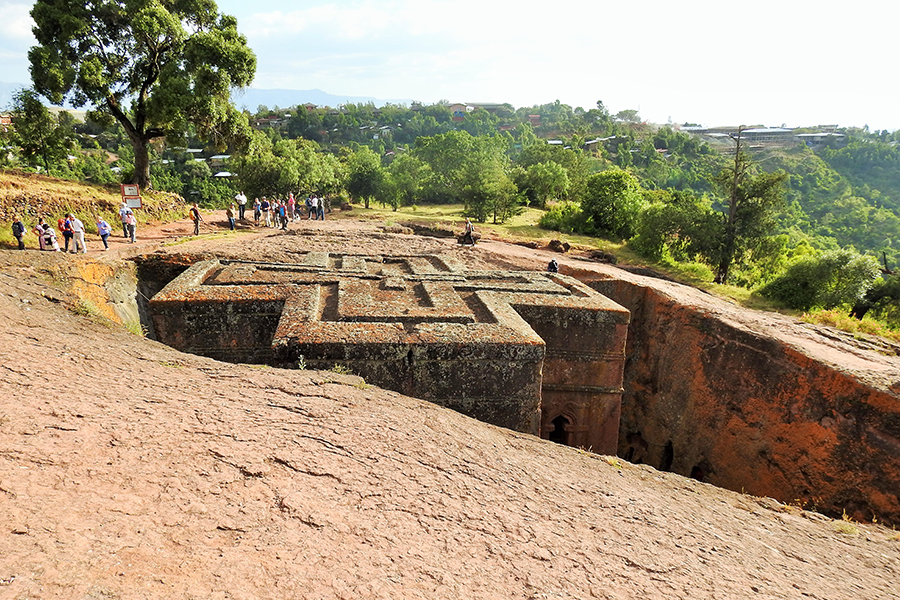
Cross of St George
- What sort of food and drink can travellers expect in Ethiopia? Is it a good destination for vegetarians or people with other dietary requirements?
Prior to departure I had read some mixed reviews about Ethiopian food and about access to shall we say, more western style of food. So, I had prepared myself to be eating Ethiopian food for a month and I was hoping that I was going to like it.
Honestly, I didn’t care for it very much. Injera which is the staple food of the entire country can be best described as a steamed fermented pancake, with a soft sponge like texture. There are many different varieties of injera, some more enjoyable than others, but overall not for me. The accompaniments generally are dips or stew (made from beef or chicken or goat, or on fasting days vegetables) and many were very tasty, but all have a fairly high chilli component. For the most part, I ate what I would eat here, with some variations.
There are 4 things to remember about eating in Ethiopia:
- Just because it is on the menu doesn’t mean it is available, even the best hotels do not always have everything they list.
- The portions are huge! It is an Ethiopian custom to do this, and no end of trying to change this as it just seemed wasteful ever changed the meal size.
- Food is rarely served hot, even if it is meant to be, so get used to lukewarm or cold food.
- Whenever unsure of what to order, just go with a tuna salad, but you must pronounce it as “toona”, or tomato soup or margarita pizza. These are available all the time and are pretty consistent everywhere you go.
Ethiopia is probably more widely known for its coffee. It is thick, strong, hot and usually served without milk. It is more like a large triple espresso. I must say it was very rare that I had a bad coffee, but it takes a little bit of fine tuning to get it the way you want it.

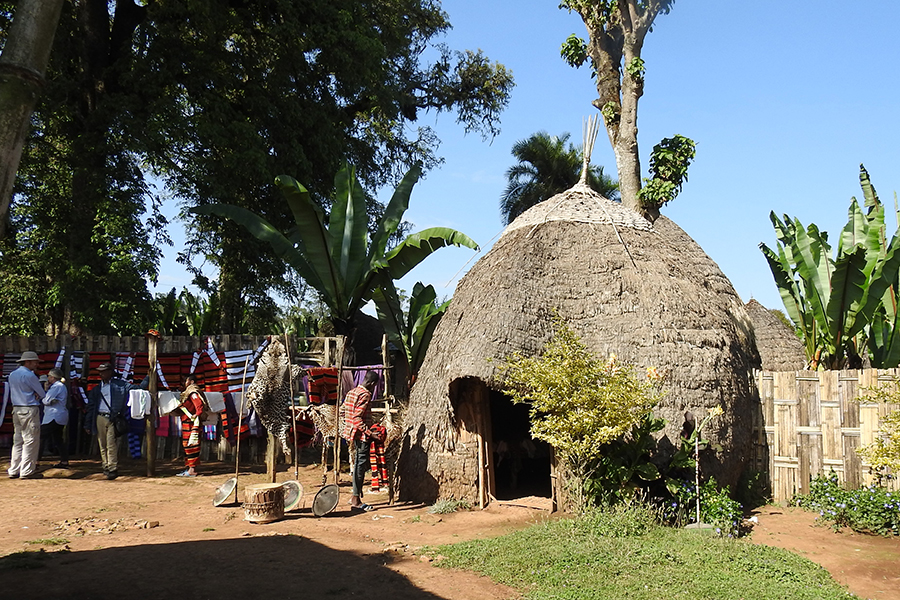
- Anything else you’d like to share about your visit? Or any tips or advice for travellers wanting to visit?
Even at the height of tourist season we didn’t really see many foreigners, which for me is great! I hate visiting a destination that is overrun by tourists, (ironic I know, given my line of business) but that is also because Ethiopia is not a mainstream destination, it is not well patronaged by westerners (volatile history has contributed to that for sure!) and it has some “facility deficiencies” which will keep one market segment away. Even the best hotels are for the most part 3 star with an unreliable water, hot water and electricity supply.
You can expect to get ill – the equivalent of Bali belly or Delhi belly… absolutely and probably more than once. I am still not sure that it is related to the food, I would avoid dairy though, which was really hard with fantastic coffee on offer, I prefer milk coffee! And the best option is erring closer to the vegetarian side of things.Take with you antibacterial everything – soap, wash, cream, scrubs, biotics, the works! I wish I knew the hand sanitiser lotion doesn’t work on viral gastro! It’s always better to be prepared for these situations ahead of time.
I’d recommend doing some homework before you leave. Understand about famous Ethiopians – use them as an “in” to start a conversation. Know a little about the history and if your trip is focusing on the north, then most definitely brush up on your bible – old testament is better! Our guide would start every sentence when talking about the bible with…. “As you know, in the Bible….” and I am sorry to say that most of the time we didn’t know but do now!
Overall, I thoroughly appreciated and enjoyed the destinations I visited and above all, the diversity of Ethiopia was amazing! However, I would not recommend it for a first-time traveller to Africa. Organisation and planning are essential, as is a knowledgeable guide and a fun group of companions of course!


